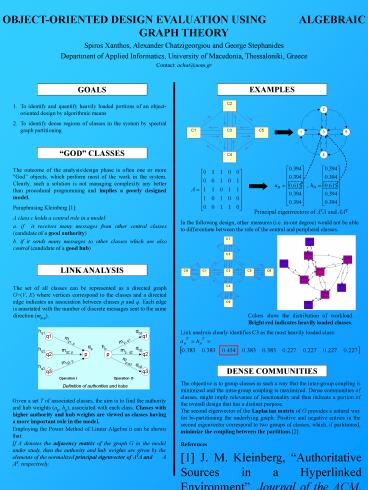?a???s?as? t?? PowerPoint - PowerPoint PPT Presentation
1 / 1
Title:
?a???s?as? t?? PowerPoint
Description:
... is often one or more 'God' objects, which perform most of the work in the system. ... matrix of the graph G in the model under study, then the authority and hub ... – PowerPoint PPT presentation
Number of Views:14
Avg rating:3.0/5.0
Title: ?a???s?as? t?? PowerPoint
1
OBJECT-ORIENTED DESIGN EVALUATION USING
ALGEBRAIC GRAPH THEORY Spiros Xanthos, Alexander
Chatzigeorgiou and George Stephanides Department
of Applied Informatics, University of Macedonia,
Thessaloniki, Greece Contact achat_at_uom.gr
GOALS
EXAMPLES
- To identify and quantify heavily loaded portions
of an object-oriented design by algorithmic means - To identify dense regions of classes in the
system by spectral graph partitioning
GOD CLASSES
The outcome of the analysis/design phase is often
one or more "God objects, which perform most of
the work in the system. Clearly, such a solution
is not managing complexity any better than
procedural programming and implies a poorly
designed model. Paraphrasing Kleinberg 1 A
class c holds a central role in a model a. if
it receives many messages from other central
classes (candidate of a good authority) b. if it
sends many messages to other classes which are
also central (candidate of a good hub)
Principal eigenvectors of ATA and AAT
In the following design, other measures (i.e.
in-out degree) would not be able to differentiate
between the role of the central and peripheral
classes.
LINK ANALYSIS
The set of all classes can be represented as a
directed graph G(V, E) where vertices
correspond to the classes and a directed edge
indicates an association between classes p and q.
Each edge is annotated with the number of
discrete messages sent to the same direction
(mp,q).
Colors show the distribution of workload. Bright
red indicates heavily loaded classes.
Link analysis clearly identifies C3 as the most
heavily loaded class
DENSE COMMUNITIES
The objective is to group classes in such a way
that the inter-group coupling is minimized and
the intra-group coupling is maximized. Dense
communities of classes, might imply relevance of
functionality and thus indicate a portion of the
overall design that has a distinct purpose. The
second eigenvector of the Laplacian matrix of G
provides a natural way for bi-partitioning the
underlying graph Positive and negative entries
in the second eigenvector correspond to two
groups of classes, which, if partitioned,
minimize the coupling between the partitions 2.
Given a set T of associated classes, the aim is
to find the authority and hub weights (ap, hp),
associated with each class. Classes with higher
authority and hub weights are viewed as classes
having a more important role in the model.
Employing the Power Method of Linear Algebra it
can be shown that If A denotes the adjacency
matrix of the graph G in the model under study,
then the authority and hub weights are given by
the elements of the normalized principal
eigenvector of ATA and A AT, respectively.
References 1 J. M. Kleinberg, Authoritative
Sources in a Hyperlinked Environment, Journal of
the ACM, vol. 46, issue 5, Sep. 1999, pp.
604-632. 2 M. Fiedler, A property of
eigenvectors of nonnegative symmetric matrices
and its application to graph theory,
Czechoslovak Mathematical Journal, 25 (1975), pp.
619-633.






























